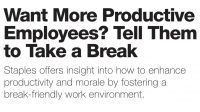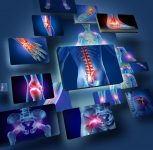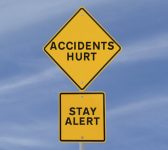Modern safety management goes beyond covering traditional workplace accidents to now being equally concerned with illnesses caused on and even off the job. This section will explain what you need to know to avoid both injuries and illnesses, and to track your progress in reaching this goal.
Free Special REport: Does Your PPE Program Meet OSHA’s Requirements?
A recent Staples survey confirms that 55% of employees feel that they cannot leave their desks during the day to take a break. Little do they know that the amount of effort they put in at work depends on these breaks.
By Ana Ellington, Legal Editor A number of OSHA standards are cited in relation to arc flash hazards. The NFPA 70E national consensus standard is a comprehensive standard that contains detailed information on how to protect workers from arc flashes. Employers must consider and adopt NFPA 70E when employees work on an electrical system. NFPA […]
By Ana Ellington, Legal Editor An arc flash is an undesired electric discharge that travels through the air between conductors or from a conductor to a ground. The flash is immediate, but the result of these incidents can damage equipment and cause severe injury, including burns. According to the National Fire Protection Association (NFPA) 70E […]
Westermans International, a UK based welding company, recently put together an infographic about fatal and non-fatal injuries and illness in the workplace. It features statistics about the kinds of diseases and accidents that occur frequently, as well as the industries worst affected. Based on data from the Health and Safety Executive Annual Statistics Report, this […]
Computing accident incidence rates and severity can help analyze and correct conditions that cause accidents. A simple formula for calculating accident incidence (frequency) is to: Take the total number of recordable incidents for the year from your OSHA 300. Multiply that number by 200,000, which represents the number of hours worked by 100 full-time employees, […]
OSHA, gearing up for a proposed rulemaking on I2P2, is presenting its case to employers and the public. "Injury and illness prevention programs (I2P2) are good for workers, good for business, and good for America." OSHA administrator David Michaels made this statement in support of a plan that would require employers to develop written safety […]
Yesterday, we looked at the potential ergonomic pitfalls of lean manufacturing. Today, we look at the flip side: “non-value-added tasks.” What if you could reduce your manufacturing costs, improve productivity, and prevent ergonomic injuries all at once? Sound too good to be true? It may not be, according to Chris Shulenberger, Certified Professional Ergonomist with […]
“Don’t let your lean manufacturing become anorexic,” says Certified Professional Ergonomist Chris Shulenberger, M.S. Engr., and Technical Director for Ergonomics with Bureau Veritas North America. If you do, you’ll pay the price. Over the last decade, many manufacturers have embraced “lean manufacturing,” a strategy to eliminate wasted time, motion, and storage by streamlining production, altering […]
According to NIOSH, 4 million workers go to work each day in damaging noise. Ten million people in the U.S. have a noise-related hearing loss. Twenty-two million workers are exposed to potentially damaging noise each year. Because of these statistics, NIOSH recommends that all worker exposures to noise should be controlled below a level equivalent […]
The OSHA noise exposure standards says that if any employee’s exposure equals or exceeds an 8-hour time-weighted average of 85 decibels (dB), which is the “action level,” you must develop and implement a noise monitoring program. The audiometric sampling strategy for the monitoring program should be designed to identify affected employees and enable proper selection […]










